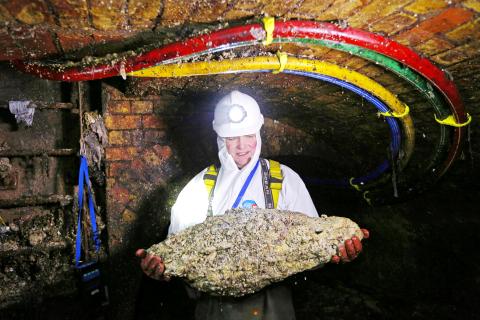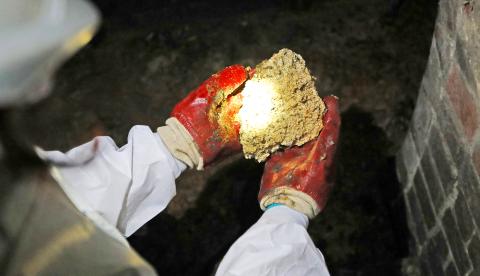Nobody remembers exactly who coined the word, but it started off as a bit of slang used by the Thames Water “flushers” who work to keep the sewers flowing freely beneath London. Their word first surfaced from those Victorian tunnels and into the newspapers in August 2013, when a bus-sized “fatberg” — a solid mass of oil and grease and undisposable disposables — was removed from a sewer in Kingston upon
Thames. After that the name caught on in the way that its rival “johnnyberg” (used by the flushers of Anglian Water, who had been struck by the preponderance of condoms in the ossified deposits) did not. “Fatberg” reached the Oxford English Dictionary in 2015 — at the same moment as “manspreading” and “Brexit” and “bantz” — and in the same year in which a record-breaking 10-tonne example broke a sewer in Chelsea costing Thames Water £400,000 (US$556,000) to fix. But it wasn’t really until last year that “fatberg” went viral.
The Whitechapel fatberg that made headlines in September was among the UK’s most infectious social media exports of last year. The units in which it was routinely measured gave away its birthplace. This being a London phenomenon it was invariably described in local currency: at 820 feet, the fatberg was “longer than Tower Bridge” or “twice as long as Wembley Stadium” and “the weight of 11 double-decker buses.”

Photo: AFP
Having once led the world in sewer engineering with Sir Joseph Bazalgette’s cavernous underground network of marvelous tunnels, London was now the undisputed global leader in sewer blockage. TV crews were dispatched from Moscow and Montreal and Madrid to stand above manhole covers along Whitechapel Road and hold their noses while Thames Water flushers in white protective suits used high-powered jet hoses and picks and shovels and vacuum pipes to break the fatberg up and then remove it in tankers at the rate of 20 to 30 tonnes per day. Ninety three per cent of its complex structure was said to consist of the element “wet wipe.” By the time the clean-up was over, and its notoriety had spread, lesser fatbergs were being unearthed in Belfast and Denver and Melbourne.
EXHIBITING A FATBERG?
It was in the first week of the discovery of the Whitechapel Monster (the hyperbole was part of the attraction, no nomenclature for the Subterranean Beast was too extreme) that the Museum of London, halfway through a series of exhibitions about modern city living , decided it must have a slice of it. Sharon Ament, the museum’s director had been thinking about the possibility of displaying a fatberg in the museum — whose collection includes a variety of valuable objects retrieved from drains and cess pits and sewers from Roman times on — since the previous big find in Chinatown in Soho. On that occasion the museum had not acted before the fatberg was destroyed; this time it was ready.

Photo: AP
(Apparently there was some talk that the Science Museum wanted a chunk of fatberg too, though when it discovered the Museum of London had first dibs there was, by some accounts, a collective sigh of relief among the curators there.)
At the end of this week, a representative chunk of the Whitechapel Leviathan will be put on display at the Museum of London. It is likely that no lavatorial exhibit will have caused quite as much a splash in the capital since Marcel Duchamp’s famous urinal went on display at the Tate, and invented conceptual art, exactly a century ago.
The woman charged with curating Fatberg! is Vyki Sparkes, who looks after social and working history at the museum.
“It was like the finger of fate pointed at me,” Sparkes says with well-scrubbed hands and a slightly rueful smile.
Sparkes is unsure yet on how high up her CV “curator of 21st-century sewage” will appear, but she is confident that the exhibition will be a worthy addition to the museum.
“If you went up to someone in the street and asked them to talk about what they put down their toilet they would tell you to bog off, basically,” she says. “But this is a way to open that conversation. We are not here to tell people how to behave, I am here to reflect how we live and to raise questions.”
FATBERGS, FATBERGS, EVERYWHERE!
Those questions are welcomed above all by Thames Water, some of whose employees have begun to feel fatbergs looming over every part of their life, crowding in on them. Alex Saunders has been working on waste networks for four of his six years with the company, but on the Whitechapel Fatberg, and its ripple effects, for most of the past four months. The East End Mammoth was, he suggests to me, “kind of a perfect fatberg storm.” A fatberg needs two principal elements to evolve. The first is a large and regular amount of oil and grease poured into sewers; the second is a population that flushes wet wipes and tampons and condoms and nappies down the toilet.
If you go and stand in Whitechapel Road, Saunders suggests, you could guess it was likely fatberg territory. It is a street lined with cafes and restaurants and takeaway outlets. Then there is the Royal London hospital, “which can lead to the flushing of some sanitary products,” and also a very high density of flats and houses.
When you walk along that stretch of road it seems extraordinary that the fatberg could evolve to such a scale beneath your feet without Thames Water noticing it — or without the sewers backing up and flooding.
Part of the reason for that is the sheer volume of the London network, Saunders suggests. The pipework is “hundreds of thousands of kilometers long” and “you cannot be sticking your head down the same bit of sewer every week.” The Whitechapel sewer, part of Bazalgette’s original brick-built labyrinth, has an inverted egg-shape cross-section; the bottom is narrower than the top so during a time of low flow there is a thin channel to keep it moving and when it rains the sewer amplifies.
The fatberg had formed along the upper part of the tunnel. Below it there was still a good flow and therefore no warning signs. “Then suddenly,” Saunders recalls, “during our normal inspections the guys popped down there and found this thing that turned out to be bigger than Tower Bridge.”
The Whitechapel Behemoth had hardened into a kind of concrete. The flusher teams have a variety of high-pressure jets, some revolving, some with chains and drill bits, to break up the bergs, which they try to use like keyhole surgery, careful not to damage the sewer itself.
“We have lots of weapons at our disposal,” Saunders says, “but sometimes, as with the Whitechapel one, it is so impacted that a lot of it is the teams going down and chiseling away by hand.”
In London, which has a magnified version of a universal problem because the sewers are so large, this work never stops. Thames Water has teams working full time; usually they are aware of five or six fatbergs that are growing. Some cause immediate blockages, others like the one in Whitechapel don’t. Saunders estimates the work costs £1 million a month, but that doesn’t include the collateral damage of “sewage flooding living rooms and public spaces cordoned off and out of bounds because they are contaminated.”
In many cases the job of flusher in London is a family occupation, the work traditionally passed down from father to son, much like the job of undertaker. Saunders was out with some second and third-generation sewer flushers, the other evening, men who have been doing the job for 30 years themselves. In the past, they suggested, there was a good deal of job satisfaction in the work; it had a nice psychological trajectory: they started a shift with a blockage, and ended it with the sewer flowing freely. It is only in the last few years that they have found themselves routinely hacking away at fatbergs.
When the Museum of London decided to take a chunk of the material the flushers raised an eyebrow, Sparkes recalls. The idea is that the world below street level does not invade the world above. The size of the sample was inevitably limited by what could come up through a manhole.
MUSEUM PIECE
The museum ended up with two sizeable chunks. To give a sense of its original serpentine scale they thought about installing it in a case with Victorian infinity mirrors which would extend it as far as the eye could see, but that idea was eventually abandoned.
Because the substance itself is somewhat volatile though, and of an unusual consistency, they still had to rewrite procedure to work out how to deal with it.
“We had our head of conservation look at it,” Sparkes says. “We initially thought about pickling it like one of Damien Hirst’s cows. The problem with that, we felt, was that it would likely make it liquid and runny.”
What they did instead was to dry the samples. They did this at different rates, uncertain how it would respond. In the event, the one that was dried most quickly has crumbled into pieces; the other remains intact.
Health and safety was an inevitable concern.
“Worst case scenario if it is handled incorrectly is death,” Sparkes suggests. “It has come out of the sewer so it might contain Weil’s disease.”
There was a fear it might also hide disposed needles — another hazard of the modern sewer — so it was x-rayed with that in mind. Museum staff still approach the fatberg with extreme caution, in full body protective suits and masks and disposable gloves, disinfecting as if they are in an operating room. The fatberg remains in quarantine ready to be encapsulated in a specially sealed case.
“One of the problems is you get all sorts of things that live inside it,” Sparkes says. “One of our samples unexpectedly hatched loads of flies in store.”
As well as breeding maggots, the fatberg breeds metaphors. It is hard not to think of it as a tangible symbol of the way we live now, the ultimate product of our disposable, out of sight, out of mind culture.

Cheng Ching-hsiang (鄭青祥) turned a small triangle of concrete jammed between two old shops into a cool little bar called 9dimension. In front of the shop, a steampunk-like structure was welded by himself to serve as a booth where he prepares cocktails. “Yancheng used to be just old people,” he says, “but now young people are coming and creating the New Yancheng.” Around the corner, Yu Hsiu-jao (饒毓琇), opened Tiny Cafe. True to its name, it is the size of a cupboard and serves cold-brewed coffee. “Small shops are so special and have personality,” she says, “people come to Yancheng to find such treasures.” She

Late last month Philippines Foreign Affairs Secretary Theresa Lazaro told the Philippine Senate that the nation has sufficient funds to evacuate the nearly 170,000 Filipino residents in Taiwan, 84 percent of whom are migrant workers, in the event of war. Agencies have been exploring evacuation scenarios since early this year, she said. She also observed that since the Philippines has only limited ships, the government is consulting security agencies for alternatives. Filipinos are a distant third in overall migrant worker population. Indonesia has over 248,000 workers, followed by roughly 240,000 Vietnamese. It should be noted that there are another 170,000

Hannah Liao (廖宸萱) recalls the harassment she experienced on dating apps, an experience that left her frightened and disgusted. “I’ve tried some voice-based dating apps,” the 30-year-old says. “Right away, some guys would say things like, ‘Wanna talk dirty?’ or ‘Wanna suck my d**k?’” she says. Liao’s story is not unique. Ministry of Health and Welfare statistics show a more than 50 percent rise in sexual assault cases related to online encounters over the past five years. In 2023 alone, women comprised 7,698 of the 9,413 reported victims. Faced with a dating landscape that can feel more predatory than promising, many in

“This is one of those rare bits of TikTok fitness advice with a lot of truth behind it,” says Bethan Crouse, performance nutritionist at Loughborough University. “Sometimes it’s taken a bit too literally, though! You see people chugging protein drinks as they’re scanning out of their gym.” Crouse recommends the athletes she works with consume 20-30g of protein within 30-60 minutes of finishing a resistance training session. “The act of exercising our muscles increases the breakdown of muscle proteins,” she says. “In order to restore, or hopefully improve them — and get gains such as increased muscle mass or strength —